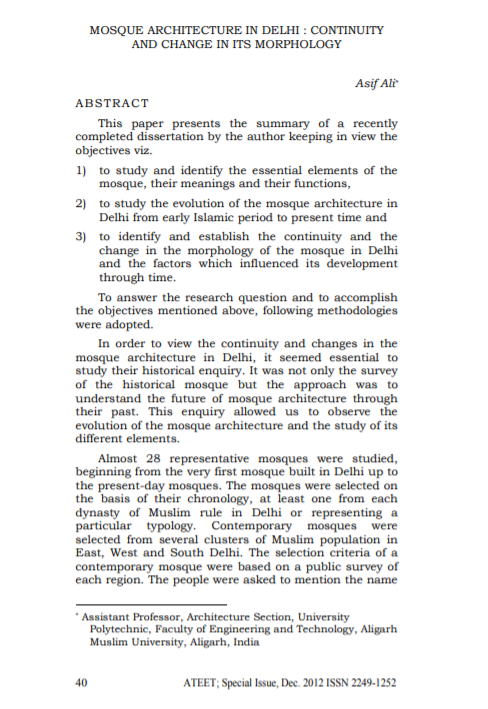
This paper presents the summary of a recently completed dissertation by the author keeping in view the objectives viz. 1) to study and identify the essential elements of the mosque, their meanings and their functions, 2) to study the evolution of the mosque architecture in Delhi from early Islamic period to present time and 3) to identify and establish the continuity and the change in the morphology of the mosque in Delhi and the factors which influenced its development through time. To answer the research question and to accomplish the objectives mentioned above, following methodologies were adopted. In order to view the continuity and changes in the mosque architecture in Delhi, it seemed essential to study their historical enquiry. It was not only the survey of the historical mosque but the approach was to understand the future of mosque architecture through their past. This enquiry allowed us to observe the evolution of the mosque architecture and the study of its different elements. Almost 28 representative mosques were studied, beginning from the very first mosque built in Delhi up to the present-day mosques. The mosques were selected on the basis of their chronology, at least one from each dynasty of Muslim rule in Delhi or representing a particular typology. Contemporary mosques were selected from several clusters of Muslim population in East, West and South Delhi. The selection criteria of a contemporary mosque were based on a public survey of each region. The people were asked to mention the name of the attractive mosque or the name of the most comfortable mosque they think in the region. The elements of mosques were studied under the headings viz. 1) Spatial elements: Ablution area, Courtyard, Verandah, Prayer Hall, Mihrab and Minber, 2) Decorative and Symbolic Elements: Domes, Minarets, Arches, Calligraphy, Geometric and Arabesque Pattern, 3) Structural Elements: Arcuated, Trabeated, Load Bearing and Framed Structure and 4) Finishing Materials: Quartz, Red Sandstone, Marble, Lime Surkhi and Cement Sand Plaster. Finally, a chart of different elements of mosques in Delhi was prepared in chronological order so that the pattern of changes and continuity may be observed and appreciated in the course of time of study.
To study the evolution of the mosque architecture in Delhi from early Islamic period to present time and to identify and establish the continuity and the change in the morphology of the mosque in Delhi and the factors which influenced its development through time.
I agree to the terms outlined below:
You agree to upload and assign Mosqpedia Database the rights to use the content worldwide and in perpetuity across all current and future media platforms. Mosqpedia Database may edit, copy, adapt and translate your contribution.
The content will be distributed under the Creative Commons Attribution-Deed – Attribution-NonCommercial-NoDerivatives 4.0 International – Creative Commons
All data will be stored in line with data protection regulations.